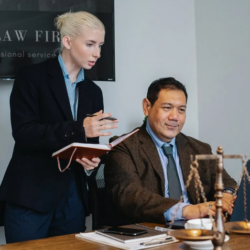How Malpractice Lawyers Prove Negligence in Court
When medical treatment goes wrong, patients often find themselves caught between physical pain and legal confusion. Proving medical negligence isn’t like pointing out a broken traffic light—it requires surgical precision in legal strategy. Malpractice attorneys become detectives, piecing together evidence that transforms “something went wrong” into “someone did something wrong.” The courtroom becomes their stage, where they must convince a jury that a healthcare provider’s actions fell below acceptable standards. Think of it as solving a puzzle where each piece represents a different aspect of medical care. Success depends on presenting a compelling narrative that connects professional duty with patient harm.
Establishing the Standard of Care
Every medical malpractice case starts with a fundamental question: what should have happened? Lawyers must first paint a picture of reasonable medical practice within the specific circumstances. Expert witnesses become the backbone of this argument, explaining what a competent doctor would have done differently. These medical professionals review charts, examine procedures, and offer their professional opinions about proper treatment protocols. The attorney’s job is translating complex medical jargon into language that resonates with everyday people. Picture a chef explaining why adding salt at the wrong time ruins a dish—the expert witness does something similar for medical procedures.
Demonstrating Breach of Duty

Once the standard is established, lawyers must prove their client’s doctor deviated from it. This requires careful examination of medical records, treatment decisions, and procedural choices. Attorneys often hire medical experts to dissect every decision made during treatment. They look for moments where the healthcare provider zigged when they should have zagged. Documentation becomes crucial evidence—what was recorded, what was omitted, and what contradicts established protocols. Sometimes the breach is obvious, like operating on the wrong limb, while other cases require deep analysis of subtle treatment choices.
Proving Causation Links
Perhaps the trickiest part of any malpractice case involves connecting the doctor’s actions to the patient’s injury. Lawyers must show that the negligent act directly caused harm, not just coincidentally occurred before it. This often means ruling out other potential causes, from pre-existing conditions to unrelated health factors. Medical experts testify about the chain of events, explaining how one decision led to another outcome. Think of it like dominoes falling—each action must logically connect to the next. Courts require proof that “but for” the negligent act, the injury wouldn’t have occurred, making this element particularly challenging to establish.
Documenting Damages and Losses

The final piece involves quantifying exactly what the negligence cost the patient. Lawyers gather medical bills, calculate lost wages, and assess future care needs. They interview family members about how the injury changed their loved one’s daily life. Pain and suffering calculations require creative presentation—how do you put a price on sleepless nights or lost independence? Economic experts often testify about lifetime earning capacity and ongoing medical expenses. The goal is to help jurors understand the full impact of negligence, from immediate medical costs to long-term life changes. Some damages are concrete, like hospital bills, while others require a more nuanced explanation.
Proving medical negligence demands more than pointing fingers at unfortunate outcomes. Successful malpractice lawyers combine legal expertise with medical knowledge, creating compelling cases that honor both professional standards and patient rights. They transform complex medical situations into understandable narratives that juries can follow and judge. The process requires patience, persistence, and exceptional attention to detail—qualities that separate effective advocates from those who merely file paperwork. When done correctly, these cases not only compensate injured patients but also promote better healthcare practices for everyone.…










 Preserving and protecting your assets for future generations is a crucial aspect of estate planning. An estate planning attorney can offer invaluable guidance on safeguarding your wealth from potential creditors,
Preserving and protecting your assets for future generations is a crucial aspect of estate planning. An estate planning attorney can offer invaluable guidance on safeguarding your wealth from potential creditors, 
 Personal injury lawyers help their clients by documenting injuries and expenses. This includes medical bills, lost wages, and other damages. Doing this can ensure that their clients are compensated for their losses. A personal injury lawyer can also help you if you have been the victim of a crime. They can help you get compensated for your losses and ensure that your rights are protected. If you have been the victim of domestic violence, a personal injury lawyer can also help you get the compensation you deserve.
Personal injury lawyers help their clients by documenting injuries and expenses. This includes medical bills, lost wages, and other damages. Doing this can ensure that their clients are compensated for their losses. A personal injury lawyer can also help you if you have been the victim of a crime. They can help you get compensated for your losses and ensure that your rights are protected. If you have been the victim of domestic violence, a personal injury lawyer can also help you get the compensation you deserve.
 The first step in filing a lawsuit against a contractor is to gather the necessary paperwork. You will need to get a summons and complaint form from your local courthouse. These forms can also be found online. Once you have the forms, you will need to fill them out and file them with the court. If you are not sure how to fill out the forms, you can ask for help from the court clerk.
The first step in filing a lawsuit against a contractor is to gather the necessary paperwork. You will need to get a summons and complaint form from your local courthouse. These forms can also be found online. Once you have the forms, you will need to fill them out and file them with the court. If you are not sure how to fill out the forms, you can ask for help from the court clerk. After completing the forms, you will need to file them with the court. You can either mail them or bring them in person to the courthouse. Be sure to keep a copy of the forms and the contract for your records. If you are filing the lawsuit yourself, you will need to pay a filing fee. The fee amount will vary depending on your state and the type of case you are filing.
After completing the forms, you will need to file them with the court. You can either mail them or bring them in person to the courthouse. Be sure to keep a copy of the forms and the contract for your records. If you are filing the lawsuit yourself, you will need to pay a filing fee. The fee amount will vary depending on your state and the type of case you are filing. Finally, if the contractor breaches the contract or causes significant damage to your home, you may need to seek legal counsel. An experienced lawyer can help you navigate the legal system and protect your rights.
Finally, if the contractor breaches the contract or causes significant damage to your home, you may need to seek legal counsel. An experienced lawyer can help you navigate the legal system and protect your rights.
 Lawyers go to law school and extensive training. Personal injury lawyers further specialize in this specific area of the law. This makes them adept and skilful at handling such cases. Going for an experienced lawyer is always the safe bet especially if your case entails monetary damages.
Lawyers go to law school and extensive training. Personal injury lawyers further specialize in this specific area of the law. This makes them adept and skilful at handling such cases. Going for an experienced lawyer is always the safe bet especially if your case entails monetary damages. Right after an accident, the last anyone wants to do is run around to do paperwork. Here is where a personal injury lawyer comes in. They will help you draft letters, forms, and statements. They do this in such a way to give you a successful case. A lawyer will protect you from losing your case just because you missed out on a minor technicality.
Right after an accident, the last anyone wants to do is run around to do paperwork. Here is where a personal injury lawyer comes in. They will help you draft letters, forms, and statements. They do this in such a way to give you a successful case. A lawyer will protect you from losing your case just because you missed out on a minor technicality.
 Arbitration is different from judicial proceedings in that, proceedings in arbitration happen in private. This confidentiality is important especially when it comes to disagreements that are related to matters that are commercially sensitive. In most instances, the individuals involved prefer to leave matters of such a nature from the public domain.
Arbitration is different from judicial proceedings in that, proceedings in arbitration happen in private. This confidentiality is important especially when it comes to disagreements that are related to matters that are commercially sensitive. In most instances, the individuals involved prefer to leave matters of such a nature from the public domain. The arbitrator makes awards that are considered final and therefore binding. This can only be disputed in particular limited circumstances. However, in an instance where a party feels that an erroneous award was made, the absence of a real right of appeal may be unpopular.
The arbitrator makes awards that are considered final and therefore binding. This can only be disputed in particular limited circumstances. However, in an instance where a party feels that an erroneous award was made, the absence of a real right of appeal may be unpopular.